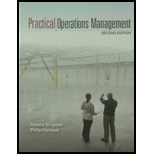
Concept explainers
Interpretation: The mean error of the HR department’s
Concept Introduction: The following formula will be used:
Answer to Problem 1.1Q
Mean error = 0.81530
Mean absolute deviation = 1.7
Mean absolute percent error = 21.88%
Explanation of Solution
The following formula will be used to calculate the mean for HR department’s forecast −
Actual attendance = 95
Total session = 10
Therefore,
The difference between actual attendance and mean attendance results the deviation from actual value.
| 12.25 | |
| 0.25 | |
| 6.25 | |
| 6.25 | |
| 2.25 | |
| 2.25 | |
| 0.25 | |
| 0.25 | |
| 30.25 | |
| 6.25 | |
| Summation | 66.5 |
The standard deviation can be calculated as −
The following method will be used to calculate the standard error −
Mean absolute deviation can be calculated as −
| error | |
| 3 | |
| 0 | |
| 2 | |
| 2 | |
| -2 | |
| 1 | |
| -1 | |
| -1 | |
| -6 | |
| -3 | |
| Summation | 17 |
The following formula will be used to calculate the mean absolute error for each component −
Therefore,
| Actual attendance | error | |
| 13 | 3 | |
| 10 | 0 | |
| 12 | 2 | |
| 12 | 2 | |
| 8 | -2 | |
| 11 | 1 | |
| 9 | -1 | |
| 9 | -1 | |
| 4 | -6 | |
| 7 | -3 | |
| Summation |
Want to see more full solutions like this?
Chapter 4 Solutions
Practical Operations Management
- An assessment of gender leadership and corporate culture.Kindly provide the following, citing it using in-text referencing: • A thorough exploration of gender dynamics and concepts.• Creating a clear plan to address gender bias and promote inclusive leadership.• An examination of female leadership dynamics and their impact on performance. • Comprehensive justification behind the proposal.arrow_forwardAssessment of Strategic Leadership and Global Context Provide the below in detail:· A comprehensive analysis of the current strategy,· Develop a new comprehensive strategic leadership framework that tackles the challenges of leading a global company while balancing global standards and responding to local context and challenges.· Justify a framework by drawing on and applying relevant theories of strategic leadership and global management.· It needs substantial depth and detail.· Conduct a critical evaluation of strategic leadership in a global context.arrow_forwardAssessing Leadership Ethics and Cross-cultural DiversityProvide the below with in-cite text referencing:- Investigate ethical issues and how they influence diversity and cross-cultural leadership.• Develop an ethical decision-making model that addresses cross-cultural concerns in emerging markets, such as Africa.· Conduct comprehensive analysis and modelling if necessary.- Provide a thorough ethical analysis that considers cross-cultural issues.· Careful evaluation of potential outcomes.- The proposed ethical decision-making technique is both novel and defendable.· Promoting diversity and recognising cross-cultural differences.arrow_forward
- Need help, have no idea where to start and love help upon a paper idea with no AI and soemthing original please.arrow_forwardAbout the Assignment In this course, you learned how a business chooses a positioning strategy in the marketplace and focuses on these areas by evaluating management's use of production types, creating effective productivity, and analyzing the competitiveness of production. Now you will choose a retail organization and propose a positioning marketing strategy that analyzes the organizational management decisions related to any competitiveness of cost, quality, flexibility, speed, innovation, and/or service. Prompt Choose an organization that focuses on one of these areas in the market: competitiveness of cost, quality, flexibility, speed, innovation, and/or service. An example would be choosing ALDI or LIDL. Their cost marketing positioning strategy is providing customers with international goods for a lower price and, in turn, saving business fees by not providing bagging products for free. (This is just an example. Do not use this example for your project.) Use the following steps…arrow_forwardCan you guys help me with this? Thank you! The project is Terminal 1 at JFK International Airport Here's what need to do: Time Content: What was the estimated time of the project; what was the final time (or the estimated date) of the project; what are the major contributing factors for the disparity? (Please make sure all the information here can be present around 2 minutes) Risk management content: Discuss a major risk management event that affected the project. while researching if any team member finds an interesting risk management event *Include sources that you have the information when go over these 2 parts above.arrow_forward
- I only need help with part C. Please and thank you :) ANSWERED: Gracie recorded the following times assembling a watch. Performance rating given is 95%. A) Average time of Gracie for the Operation? (round to three decimal places) ANSWER=0.107 B) normal time for this operation? (round to three decimal places) ANSWER=0.102 C) HELP PLEASE. "For a given personal allowance of 8% the standard time for the operation is how many minutes?" (round your answer to three decimal places)arrow_forwardGracie recorded the following times assembling a watch. Performance rating given is 95%. Average time of Gracie for the Operation? (round to three decimal places) normal time for this operation? (round to three decimal places)arrow_forwardAs stated before, the key advantage of the LLC is its limited liability that’s provided. When it comes to financial problems faced in their business, the LLC helps to cover the owner's personal assets, like his home or savings. Although this sounds amazing it is important to not that this is not always absolute. This being said, it’s very crucial that the owner should properly keep their finances – personal and business- separate. This will ensure that the legal protection is useful. Disadvantageously, the owner will still have to contribute to Social Security and Medicare Self-emplyment tax?arrow_forward
- Monczka Trent shipping is the logistics vendor for Handfield Manufacturing in Ohio. Handfield has daily shipments of a power steering pump from its Ohio plant to an auto assembly line in Alabama. The value of the standard shipment is $261,090. Monczka Trent has two options: (1) it's standard two day shipment or (2) a subcontractor who will team drive overnight with an effective delivery of one day. The extra driver costs $190. Handfield's holding cost is 35% annually for this kind of inventory. A) _ is more economical, with a daily holding cost of _?B) What production issues are not included in the data presented?arrow_forwardSasha is a loan processor for a bank. She's been timed performing four work elements. The allowances for tasks such as this are personal, 7%; fatigue. 8%; fatigue, and delay of 2%. The normal time for the complete operation = (round your irresponsive two decimal places) Standard time for this process = (round your response to 2 decimal places)arrow_forwardagree or disagree with post The tripartite model of culture is based on three cultural prototypes, face, dignity, and honor that represent negotiators’ self-views and are highly correlated with particular geographic regions. According to Vaughn (2023), “face cultures highly value maintaining social harmony and avoiding public embarrassment. People in these cultures are sensitive to the impact of their actions and words on their own and others’ social standing” (p. 1). An example of this in certain societies would be known as losing face. With respect to dignity, “dignity cultures derive self-worth from a sense of inherent human dignity and individual autonomy. Rooted in the concept of intrinsic worth unaffected by external factors, these cultures emphasize personal rights, equality, and respect for all individuals” (Vaughn, 2023, p. 1). An example of this in certain societies would be losing your self-worth. Lastly, in discussing honor cultures, it “links an individual’s self-worth…arrow_forward
- MarketingMarketingISBN:9780357033791Author:Pride, William MPublisher:South Western Educational Publishing
 Practical Management ScienceOperations ManagementISBN:9781337406659Author:WINSTON, Wayne L.Publisher:Cengage,
Practical Management ScienceOperations ManagementISBN:9781337406659Author:WINSTON, Wayne L.Publisher:Cengage, Contemporary MarketingMarketingISBN:9780357033777Author:Louis E. Boone, David L. KurtzPublisher:Cengage Learning
Contemporary MarketingMarketingISBN:9780357033777Author:Louis E. Boone, David L. KurtzPublisher:Cengage Learning  Management, Loose-Leaf VersionManagementISBN:9781305969308Author:Richard L. DaftPublisher:South-Western College Pub
Management, Loose-Leaf VersionManagementISBN:9781305969308Author:Richard L. DaftPublisher:South-Western College Pub





